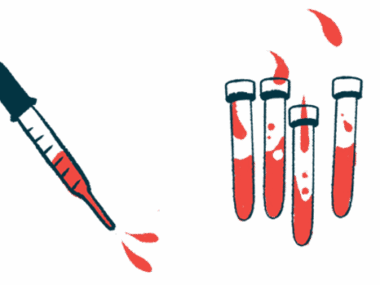Uplizna reduces immune B-cell subsets linked to disease activity
These immune B-cells increase in patients before disease relapses
Written by |

Uplizna (inebilizumab) treatment markedly reduces the number of several subsets of immune B-cells that are linked to disease relapses in people with neuromyelitis optica spectrum disorder (NMOSD), trial data show.
The therapy also lowers levels of the self-reactive antibodies against the AQP4 protein that drive most NMOSD cases, but these levels show a weaker association with disease activity.
These are the findings of a post-hoc analysis of data from the Phase 2/3 N-MOmentum clinical trial (NCT02200770), which supported the therapy’s approval for NMOSD around the world. Post-hoc analyses are those specified and performed after a trial is complete.
The results shed further light on the mechanisms behind NMOSD relapses and Uplizna’s ability to lower relapse rates in this patient population.
The study, “B cell and aquaporin-4 antibody relationships with neuromyelitis optica spectrum disorder activity,” was published in the Annals of Clinical and Translational Neurology.
Anti-AQP4 antibodies contribute to abnormal immune attacks
NMOSD is a rare autoimmune disease marked by abnormal immune attacks against healthy parts of the brain and spinal cord. In most cases, anti-AQP4 antibodies contribute to these abnormal immune attacks.
Self-reactive antibodies, as well as regular antibodies against potential threats, are produced by immune B-cells, making them a therapeutic target in NMOSD.
Uplizna is an antibody-based therapy designed to promote the death of B-cells by binding to the CD19 protein, which is highly present at the surface of B-cells throughout their maturation process.
CD20 is another hallmark surface protein of B-cells, but it is lost in plasmablasts (PBs), short-lived B-cells that can secrete small amounts of antibodies, and totally absent in plasma cells (PCs), the long-lived and fully mature B-cells that produce the largest number of antibodies.
While certain B-cells mature into plasma cells, others become long-lived memory B-cells, which can persist in the body for a lifetime to rapidly mature into plasma cells when they reencounter a threat.
Uplizna’s approvals were backed by data from the N-MOmentum study, which showed the therapy reduced the risk of relapse by 77% relative to a placebo among patients who were positive for anti-AQP4 antibodies.
After completing the placebo-controlled period, participants could enter the trial’s open-label extension, in which all received Uplizna and were followed a minimum of two years.
In this post-hoc analysis of N-Momentum data, researchers assessed how the levels of circulating B-cell subsets and those of anti-AQP4 antibodies correlated with NMOSD relapse.
Patients who experienced relapse show increase in certain B-cell subsets
Those who experienced a relapse while on the placebo showed a significant increase in the numbers of overall CD20-positive B-cells, non-activated immature B-cells (naïve B-cells), and the PB/PC subset up to the time of relapse. In turn, memory B-cells showed no significant differences.
A two-fold increase in the PB/PC subset was seen in 57% of blood samples taken at the time of a NMOSD relapse versus 16% of those taken at times without attacks.
Treatment with Uplizna led to a rapid and sustained depletion of the PB/PC subset when compared with the placebo. CD20-positive, naïve, and memory B-cells also showed a significant reduction from the start of the study.
“No samples from participants who experienced attacks showed increases [in all these B-cell subsets] from [the study’s start] or pre-attack samples,” the researchers wrote.
Among patients with anti-AQP4 antibodies, a significantly greater proportion of Uplizna-treated patients showed at least a twofold drop in anti-AQP4 antibody levels relative to those on the placebo at the end of the placebo-controlled phase (37% vs. 18%). A reduction of at least eight times was seen in 11% of Uplizna-treated patients and none of those in the placebo group.
Levels of anti-AQP4 antibodies were increased up to the time of attack in both groups, but this increase was statistically significant only in the placebo group. Still, level changes from the study’s start to the time of an attack “were not significantly different between the placebo and [Uplizna] treatment groups,” the team wrote.
In addition, 85% of patients given a placebo had a twofold or greater increase in the PB/PC subset and/or anti-AQP4 antibodies, and 25% experienced an increase in both parameters.
Annual attack rate decreased with long-term Uplizna treatment
The annual attack rate progressively decreased with long-term Uplizna treatment in all groups during the trial’s extension period.
Uplizna-treated patients who tested negative for anti-AQP4 antibodies at the study’s start never developed the antibodies. Eight patients positive for the antibodies at the start of the trial achieved undetectable levels during the study.
“In conclusion, B-cell subsets (particularly those with a PB/PC gene signature) and AQP4-IgG [anti-AQP4 antibody] levels were increased in a significant proportion of untreated participants at the time of attack,” the researchers wrote.
Also, Uplizna treatment “reduced B-cell subset numbers, including PB/PC and AQP4-IgG titers, impacting relapse risk, which supports targeting [CD19-positive] B cells as a mechanism for reducing the likelihood of attacks,” they concluded.







